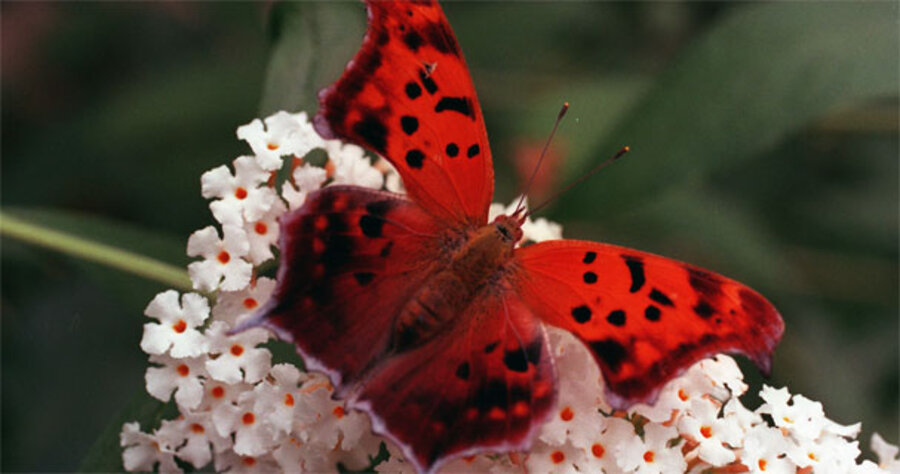Winged jewels in your yard
Butterflies have favorite places and favorite foods, just as you do. If you provide both of them in your yard, you'll get to see these beautiful winged creatures up close.
It's easy to plant a garden that will attract many types of butterflies. And it doesn't have to be big.
You'll want to plant your garden in a sunny area. Butterflies prefer open, sunny spaces, because the sun's warmth makes flowers produce more nectar, the sweet liquid found in flowers. The sun also keeps a butterfly's body temperature high, which helps it survive.
A garden needs good soil. Take the time to work the soil in your garden with a hoe or a trowel. Loosen it enough so that you can dig freely in it with your hands or shovel. The soil shouldn't have rocks, chunks of clay, or weeds in it.
You'll want to plant flowers that butterflies like to visit. These are usually ones with brightly colored blooms – red, purple, pink, and yellow. Butterflies especially like large flowers so they can rest on them while they drink nectar. See the lists at left for more suggestions of good plants for a butterfly garden.
Those that are easy to start from seed include zinnias (red, pink, yellow, or orange); Mexican sunflowers (gold); cosmos (yellow, red, and pink); nasturtiums (red, orange, and yellow); and marigolds (red, yellow, and orange).
If you plant seeds, follow the directions on the back of the package. It will tell you the right time to plant the seeds according to where you live, and also how deep the seeds should be planted in the soil.
Even simpler than sowing seeds is buying bedding plants of flowers that appeal to butterflies. (They are already started in little pots and are ready to bloom.) These cost more, though.
When your garden is growing and blooming, sit back and watch for butterflies. Their life cycle has four stages – egg, caterpillar (larva), chrysalis (pupa), and adult – and they prefer different food (plants) at different stages.
Butterflies also look for special places to lay their eggs. Monarch butterflies prefer milkweed leaves, while parsley attracts many other butterflies. Larva of various butterflies like to eat aster, Queen Anne's lace, hollyhock, violet, and white clover. If you grow these as well as nectar plants, butterflies will stay in your yard for their whole life cycle.
As a caterpillar grows, it sheds its skin and produces new skin several times. When it starts to hang downward by its feet and twitch and twist, the caterpillar is getting ready to make a chrysalis or pupa. It sheds its skin for the last time, and the new skin begins to harden. When the chrysalis is hard, the creature can hardly move, except to wiggle its abdomen slightly.
In the final stage, the shell of the pupa splits, and a full-grown butterfly emerges, weak and covered with moisture. It crawls to a twig or other resting place, hangs its head downward, and waves its wings.
Gradually, the wings unfold, and the butterfly is ready to look for food. Adult butterflies have chemical receptors on their tongues, antennae, and feet to detect the scent of nectar. They also have a long, thin proboscis, which looks kind of like a straw, that they uncurl into the flower to get at the nectar.
Watching colorful butterflies is fun. Why not check out a butterfly book from the library? Then you can try to identify the monarchs, sulphurs, swallowtails, and other butterflies that visit your garden.
Helpful tips for your butterfly garden
1. Avoid the use of insecticides in your garden even though some plants won't look good because caterpillars will munch on them. Instead of spraying – and killing the caterpillars that will turn into butterflies – place the plants that caterpillars use for food behind some blooming nectar plants. (See plant selections below.)
2. Water regularly. Don't let soil around young plants get too dry.
3. Provide "landing pads" – flat rocks – in the garden so butterflies can bask in the sun. Butterflies like puddles, too.
Good nectar plants
Aster
Black-eyed Susan
Butterfly weed
Catmint
Coreopsis
Cosmos
Daisies
Daylily
Goldenrod
Hibiscus
Hollyhock
Lavender
Marigold
Morning Glory
Nasturtium
Pansy
Phlox
Purple coneflower
Sunflower
Verbena
Zinnia
Good food plants
Grow these so different types of caterpillars will eat these plants, spin into chrysalides, and then become butterflies – all in your yard.
Broccoli
Cabbage
Carrot
Dill
Hollyhock
Milkweed
Pansy
Parsley
Snapdragon
Violet
Willow trees





